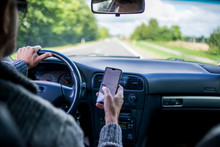Distracted Driving Accidents
We all have seen drivers distracted by cell phones and other electronic devices.

Distracted driving presents a growing risk of injury and death on the highways of Georgia and throughout the United States. As experienced Atlanta lawyers handling personal injury and wrongful death cases statewide in Georgia, we have dealt with all the sources of driver distraction.
How many auto accidents are due to driver distraction?
Public awareness of driver distraction is a widespread public safety problem, which is roughly comparable to awareness of drunk driving hazards 40 years ago. These numbers of distracted driving accidents are vastly underreported because most people who cause a crash while distracted do not admit that to a police officer.
What are the 10 most common sources of driver distraction?
- Generally distracted or “lost in thought” – 62%. A driver may be distracted by thoughts of work, family, or anything else in life just long enough to have a tragic consequence. You probably have experienced this on a long car trip, realizing you had driven miles without conscious thought. The only way to get information about this form of distraction is patient cross-examination of the driver who caused the crash in a deposition.
- Cellphone use – 12%. We have handled numerous crash cases in which a driver talked on a cell phone or texted. In one of our cases, we discovered through cell phone billing records and aggressive despositoin questioning that a truck driver had been on the phone with a relative in Colombia for 25 minutes before crashing into a line of stopped traffic he never saw. There are studies indicating cell phone use while driving is roughly equivalent to 0.08 gr/% drunk driving. Even hands-free cell phone use may present a serious driving hazard. Since 2018, Georgia’s hands-free law has banned holding or supporting a phone with any part of your body; writing, sending, or reading text messages, emails, or social media content; watching or recording videos, except for GPS navigation or continuously running dash cams; and using more than one button on a phone to make or end a call. However, that is tough to enforce.
- Outside person, object, or event – 7%. One common distraction is simply looking at someone or something outside the vehicle, like rubbernecking at an accident scene or at a person on the sidewalk/
- Other occupants – 5%. While casual conversation may not be much of a distraction, more intense interaction with other people in the car can place major demands on your attention. We had one case in which a dump truck driver took his live-in girlfriend in the truck, delivering crushed rock from a quarry to a road construction site. They were arguing in the truck when he crashed into our client, who was waiting to make a left turn onto a freeway ramp.
- Using or reaching for a device brought into the car – 2%. We had a fatal truck accident case in which a truck driver was reaching for a water bottle he had dropped on the floor. Distracted from watching the road ahead, he ran over a car and killed a woman.
- Eating or drinking – 2%. People who attempt to eat anything messy or difficult to handle are particularly prone to driver distraction accidents. A teen family member when learning to drive often joked about seeing a driver eating a burrito while talking on a cell phone and reading the newspaper. While that was a joking exaggeration, it is tragic when a driver feels a ketchup spill is in the moment more important than the safety of other people on the highway.
- Adjusting audio or climate controls – 2%. We have seen cases in which a driver adjusting air conditioning or radio for a moment led to a tragic crash.
- Adjusting devices or controls – such as mirrors and seatbelts — in operation of the vehicle – 1%.
- Moving objects – 1%. We have had unfortunate cases caused by a driver were swatting at a bee or dealing with a dog moving around in the vehicle.
- Smoking related – 1%. A driver may be distracted by lighting or putting out a cigarette or cigar or dropping a lit cigarette on the driver’s lap.
How can you prove driver distraction in court?
Driver distraction is often suspected but unproven unless the driver admits to it. There are no chemical tests for driver distraction. Police do not check cell phones without a search warrant, for which probable cause would be required. In catastrophic injury and wrongful death lawsuits, we subpoena cell phone billing records of the driver at fault whenever possible. Still, defendants use numerous excuses to block access to records of calls and texting. In one trucking wrongful death case, the local prosecutor issued a search warrant for the truck driver’s cell phone to get a forensic examination. That revealed that the truck driver was extremely fatigued as he had had only three hours of sleep the night before running over a line of stopped traffic, killing a young woman on her way to work. After obtaining cell phone records, we take depositions and cross-examine the defendant driver and anyone with whom he may have been on the phone. In one such case, we obtained the phone records of a truck driver, who then admitted under cross-examination that he had been on the phone with someone in Bogota, Colombia, for twenty minutes before crashing into a line of cars stopped in traffic.
How can you preempt the defense from claiming the victim was distracted by a cell phone?
First, preserve the victim’s cell phone without any tampering. Then, submit it for an independent forensic examination to determine the history of its use leading up to the incident. In one recent wrongful death case, we knew the defense would reflexively blame the victim who was impaled on a load of logs extending twenty feet from the rear of a trailer. We conducted a forensic examination of his phone, which revealed that it had been nearly two hours since the last use. We provided the voluminous forensic report to the insurance company along with our demand and collected the cumulative policy limits of $1.6 million without filing a lawsuit.
What is inattention blindness?
Distracted driving accidents’ causes relate to a psychological phenomenon called “inattentional blindness.” A person whose mind is on one thing may fail to perceive clearly visible things right before him. A driver preoccupied with a cell phone conversation – even hands-free – may fail to see a red light or stop sign.
We offer free consultation*. Call us today at 404-253-7862 or fill out our online form. We can help.












